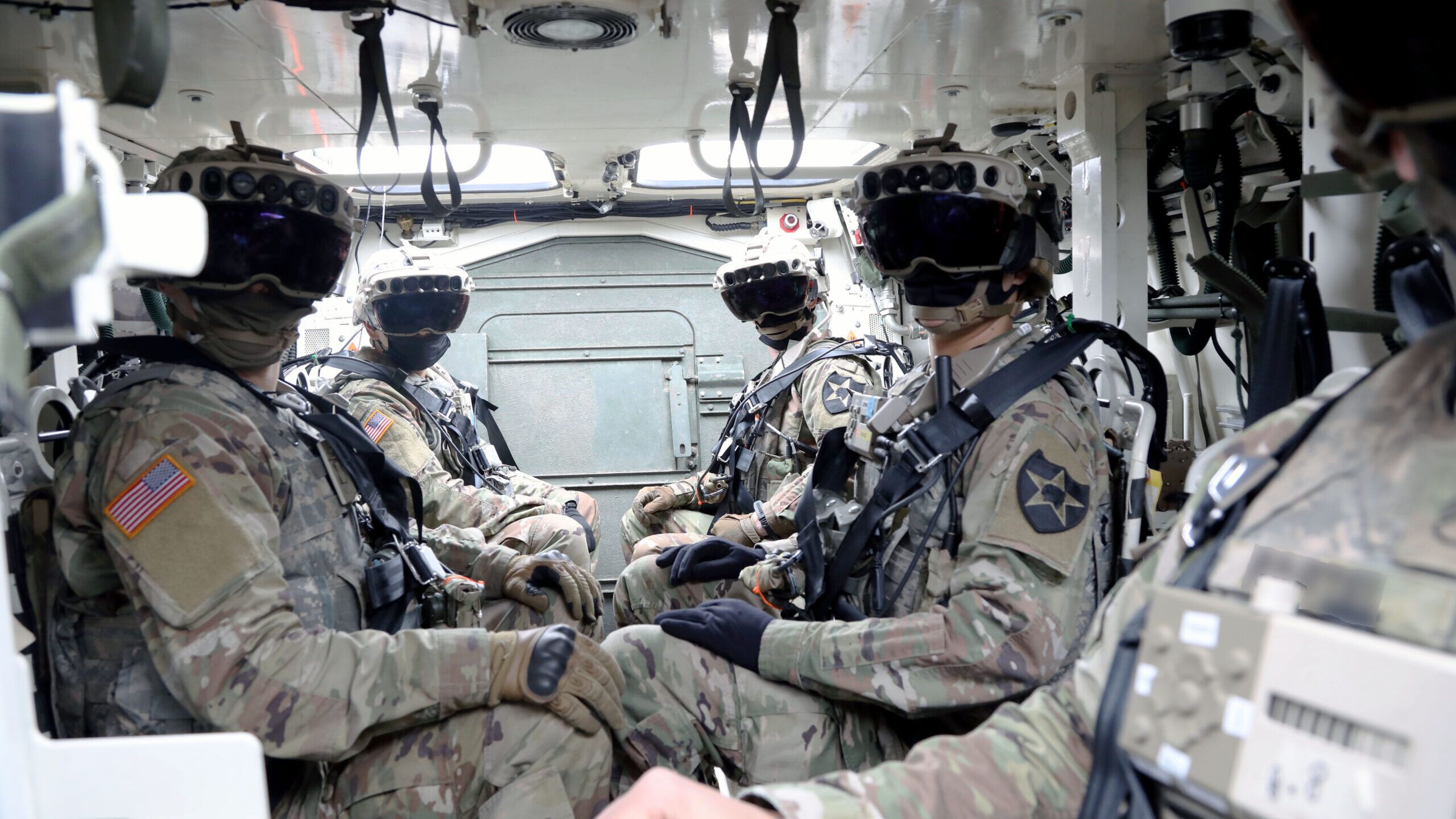
Soldiers don the Integrated Visual Augmentation System Capability Set 3 hardware while mounted in a Stryker in Joint Base Lewis-McCord, WA. (Courtney Bacon/US Army)
WASHINGTON: The Army’s next-generation augmented reality goggle is meant to allow soldiers to see well beyond what’s actually in front of their eyes, but the Pentagon’s official watchdog says the Army was blind to a potentially huge problem: What if soldiers just don’t want the nearly $22 billion system?
In a report released publicly today, the Pentagon’s inspector general bluntly takes the Army to task over the Integrated Visual Augmentation System (IVAS), saying, “Procuring IVAS without attaining user acceptance could result in wasting up to $21.88 billion in taxpayer funds to field a system that Soldiers may not want to use or use as intended.” It’s a conclusion with which Army officials hotly disagreed.
The partially redacted 50-page report alleges IVAS program officials “did not define clear measures of user acceptance levels to determine whether IVAS will meet user needs.” The Army did use surveys to get soldier feedback on the system, and the report notes that “the surveys show both positive and negative user acceptance.” The survey responses themselves appear to be included but are totally redacted. Still, the report suggested the surveys were insufficient to determine whether soldiers would actually want to use the new system.
RELATED: Into the military metaverse: An empty buzzword or a virtual resource for the Pentagon?
“Officials also stated that challenges to assessing user acceptance included asking the right questions, Soldiers not liking change, comparing prototype ‘in process’ systems to current capabilities, and lack of Soldier knowledge or training on new systems,” the report says.
The report’s conclusion is mostly redacted except to say that program officials “stated that, if Soldiers do not love IVAS and do not find it greatly enhances accomplishing the mission, then Soldiers will not use it. Army officials should establish policy requiring program officials to define suitable user acceptance levels measurements [REDACTED].” (The IG’s website indicates the original report was published on April 20, but that was a non-public “controlled unclassified information” version — a controversial designation recently adopted by the Pentagon that’s drawn the ire of lawmakers.)
The unusually stinging report was met with an unusually stinging response from the office of Douglas Bush, the assistant secretary for Army acquisition, logistics and technology, especially when it came to the use of the term “wasting.”
“This is fundamentally flawed and inflammatory, and must be removed or rewritten,” reads part of the management response section included in the report. “If re-written, the word ‘wasting’ must be removed. It is a biased word, intended to illicit an emotionally negative belief in a fictional outcome, without fact or proof.”
On the dollar figure, the program officials pointed out that $21.88 billion was the ceiling potential cost for the program over 10 years, and said it’s possible the Army would really spend “less than half of this total,” with other services or foreign militaries may pick up the rest.
“The Assistant Secretary also stated that IVAS must meet a set of performance measures based on entrance criteria before operational testing and that user acceptance is part of data collected to evaluate suitability,” the report says. “He explained that there is inherent tension between user acceptance and opportunity and provided examples where Soldier acceptance was initially low, such as night vision goggles, machine guns, and automated transport replacing horses.”
Finally, Bush reportedly argued that user acceptance is a hard thing to quantify.
Still, while broadly disagreeing with the IG’s findings, the Army did concur or partially concur with some recommendations to better evaluate “acceptance measures.” Spokespeople for the Army and Army Futures Command, which works with the system, did not immediately respond to Breaking Defense’s request for additional comment.
The Army has already been battling through months-long delays with the Microsoft-made IVAS program, after issues arose in October with the high-tech goggle’s field of view. At the time, Army officials said they “remain[] committed to getting the best equipment in the hands of our Soldiers as quickly as possible.”
Then, in March, lawmakers put $349 million in procurement funding for the IVAS on hold, calling the request “ahead of need,” until the system completed initial operational testing. Later that month the Army published its fiscal 2023 budget request, asking for about $400 million for the IVAS program, down from $854 million the year before.






















